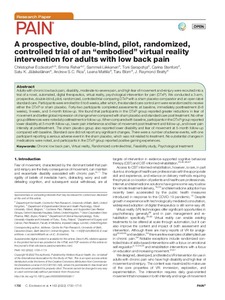A prospective, double-blind, pilot, randomized, controlled trial of an "embodied" virtual reality intervention for adults with low back pain
Mattila Leena; Stenfors Carina; Fisher Emma; Eccleston Christopher; Sarapohja Toni; Bratty Raymond J; Liikkanen Sammeli; Rice Andrew S C; Blom Taru; Jääskeläinen Satu K
A prospective, double-blind, pilot, randomized, controlled trial of an "embodied" virtual reality intervention for adults with low back pain
Mattila Leena
Stenfors Carina
Fisher Emma
Eccleston Christopher
Sarapohja Toni
Bratty Raymond J
Liikkanen Sammeli
Rice Andrew S C
Blom Taru
Jääskeläinen Satu K
LIPPINCOTT WILLIAMS & WILKINS
Julkaisun pysyvä osoite on:
https://urn.fi/URN:NBN:fi-fe2022102462990
https://urn.fi/URN:NBN:fi-fe2022102462990
Tiivistelmä
Adults with chronic low back pain, disability, moderate-to-severe pain, and high fear of movement and reinjury were recruited into a trial of a novel, automated, digital therapeutics, virtual reality, psychological intervention for pain (DTxP). We conducted a 3-arm, prospective, double-blind, pilot, randomized, controlled trial comparing DTxP with a sham placebo comparator and an open-label standard care. Participants were enrolled for 6 to 8 weeks, after which, the standard care control arm were rerandomized to receive either the DTxP or sham placebo. Forty-two participants completed assessments at baseline, immediately posttreatment (6-8 weeks), 9-week, and 5-month follow-up. We found that participants in the DTxP group reported greater reductions in fear of movement and better global impression of change when compared with sham placebo and standard care post treatment. No other group differences were noted at posttreatment or follow-up. When compared with baseline, participants in the DTxP group reported lower disability at 5-month follow-up, lower pain interference and fear of movement post treatment and follow-up, and lower pain intensity at posttreatment. The sham placebo group also reported lower disability and fear of movement at 5-month follow-up compared with baseline. Standard care did not report any significant changes. There were a number of adverse events, with one participant reporting a serious adverse event in the sham placebo, which was not related to treatment. No substantial changes in medications were noted, and participants in the DTxP group reported positive gaming experiences.
Kokoelmat
- Rinnakkaistallenteet [19207]
